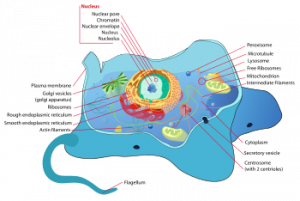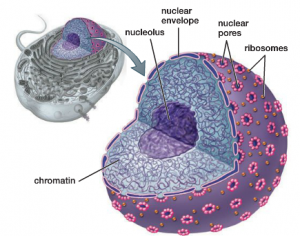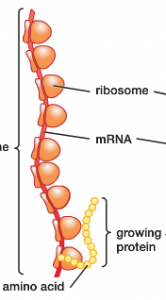Nucleus
Introduction
The nucleus is the most distinctive organelle found in eukaryotic cells. It serves as the storage site for the cell’s genetic material, DNA, and directs the activities of the cell in response to signals received from other cells or the external environment.

Nucleus
The nucleus is the most distinctive organelle found in eukaryotic cells. It serves as the storage site for the cell’s genetic material, DNA, and directs the activities of the cell in response to signals received from other cells or the external environment.
In the manufacturing plant analogy, the nucleus would be like the main administrative offices of the cell.

The nucleus of eukaryotes contains the following 3 elements:
- Nuclear Envelope
- Chromatin
- Nucleolus
We’ll explore each of these elements in more detail now.
NUCLEAR ENVELOPE
- The boundary of the nucleus, called the nuclear envelope, is a double membrane that contains small openings called nuclear pores. These pores are gateways that allow molecules to move into and out of the nucleus, enabling it to communicate with the rest of the cell.

Chromatin/Chromosomes
- Chromatin (defined as ‘colored substance’), represents the long strands of DNA contained within the nucleus. We now know that chromatin is made up of DNA along with associated proteins which are packaged into discrete units called chromosomes. Humans possess 23 pairs of chromosomes, consisting of billions of nulceotides which are segmented into functional areas called ‘genes’. Most genes contain the information required to produce proteins.
- As we will learn later in the course, protein production occurs in the cytoplasm, however, the blueprint for assembling proteins is contained within the DNA locked away inside the nucleus. Therefore, copies of this information must be made inside the nucleus and transported out to the cytoplasm. This occurs through a process called ‘transcription’, where the information contained in the DNA molecule is ‘copied’ in the form of ‘messenger’ RNA which is transported from the nucleus via the nuclear pores found in the nuclear envelope out to the cytoplasm where protein production occurs.
Nucleolus (Ribosomes)
- The nucleus of eukaryotic cells typically contains a single nucleolus (meaning ‘tiny nucleus’) and is the site where the protein-producing units of the cell, ribosomes, are produced. Ribosomes are capable of reading the information contained within messenger RNA molecules to assemble a polypeptide chain using amino acid building blocks. Ribosomes can be found floating free in the cytoplasm (for producing proteins to be used in the cytoplasm) or attached to membrane structures (for producing proteins to be used in other organelles or to be exported outside the cell).

The Nucleus
The video below discusses some of the key characteristics of the Nucleus:
Ribosomes
The following video describes the tiny, protein-producing units of the cell called ‘Ribosomes’ which are produced in the nucleolus:
Summary
The endomembrane system within eukaryotic cells includes the nuclear envelope, endoplasmic reticulum (ER), Golgi apparatus, lysosomes, and other vesicles. The nucleus contains the genetic information for the cell which is used as a blueprint for the production of proteins and other macromolecules.
The nucleus can be considered as the Main Administration Offices of the cell.